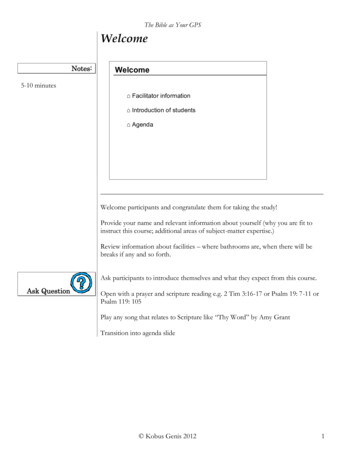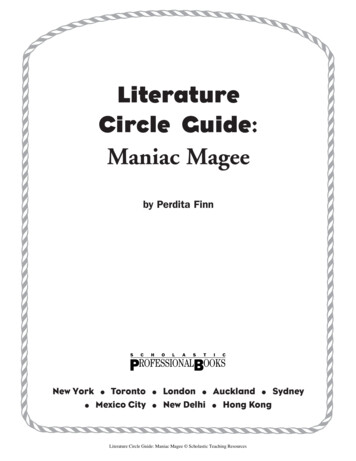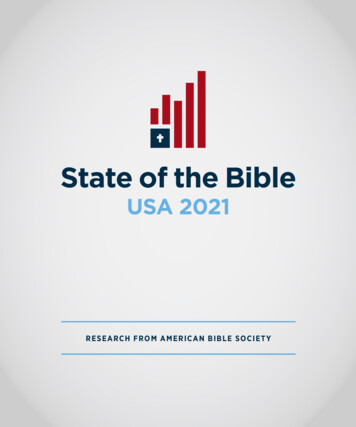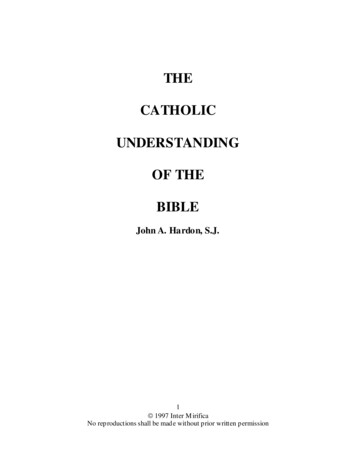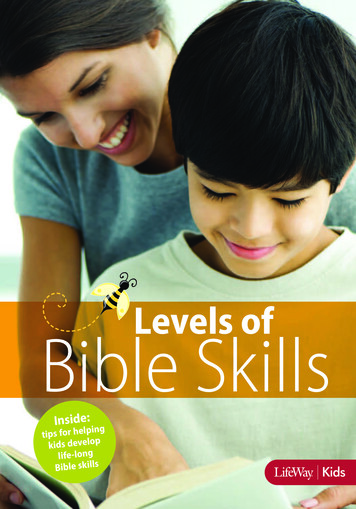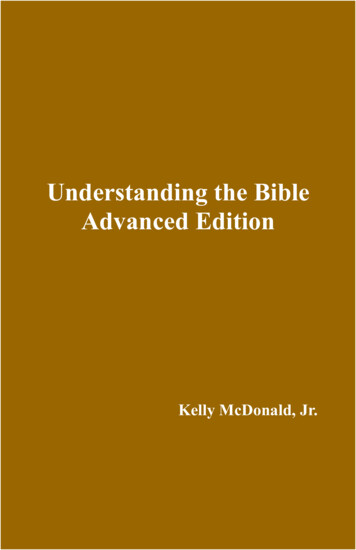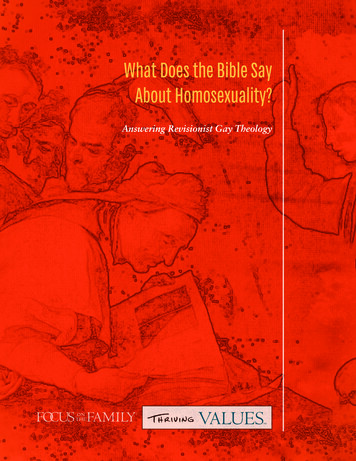
Transcription
What Does the Bible SayAbout Homosexuality?Answering Revisionist Gay Theology
What Does the Bible Say?Discussions of homosexuality or “same-sex marriage,” whether in person, in themedia or on the Internet, often turn to what the Bible says. Someone is likely toargue that homosexuality is a sin and point to Leviticus, Romans or the Genesisstory of Sodom and Gomorrah. Others will suggest homosexuality is not a sin.They’ll say things like, “Jesus never mentioned homosexuality” or “Eating shellfishand wearing a shirt with two kinds of thread are also forbidden in Leviticus, butyou don’t follow those rules, do you?”Other arguments get thrown into the mix—from both sides:I heard that Jonathan and David were gay.But God made Adam and Eve, didn’t He?Sodom and Gomorrah were destroyed because of inhospitality, not homosexuality.God says homosexuals won’t inherit the kingdom of God.Paul didn’t understand homosexuality the way we do today—he was talking abouttemple prostitution or child abuse.Gays should be killed; it says so in Leviticus.Jesus says not to judge people.The discussion often becomes convoluted, incoherent or angry, degenerating into ashouting match.Perhaps you have participated in similar discussions—face to face or online. Maybeyou’ve seen these arguments or used them yourself. You may have found yourselfwrestling with doubts about the validity of your personal convictions and thetraditional Christian understanding of homosexuality and same-sex relationships.If so, this booklet is for you.God’s original design for human sexuality will be the starting point for thisdiscussion of Christian sexual ethics. We’ll look at some of the possible reasonspeople might struggle with homosexuality. Then we’ll look at specific passages inthe Bible and respond to some of the revisionist arguments against the Church’straditional, biblical interpretation and teaching. And we’ll conclude with anexhortation for Christians who engage in this discussion.Why this matters: understanding the timesAlong with the broader sexual revolution that began to develop during the ’50sand ‘60s, a strong activist movement has worked to create new categories of “civilrights” defined by “sexual orientation,” a vague term which can include sexualand romantic attractions, identity or behavior. Currently, this homosexual activist2
What Does the Bible Say?ideology has significantly influenced every area of our culture—including a segmentof the Church.Just think about our entertainment, where homosexual charactersand dialogue are commonplace in movies and on TV. In fact,lesbian-, gay- and bisexual-identified (LGB) characters probablyoutnumber positive portrayals of Christians, who actually comprisea much larger percentage of the population. In the news media,those who oppose marriage redefinition are often given negativelabels such as “anti-gay,” “bigoted” or “anti-equality.”Curricula and literature affirming homosexuality have madetheir way into public schools, even for kids in kindergarten! Bothbusiness and government sectors have been pressured into offeringsame-sex benefits and “diversity” training for their employees.Several mainline denominations now allow the blessing ofhomosexual unions and the ordination of gays and lesbians.It’svital thatChristiansstep up andpresent avision ofGod’s positiveYet the responsibility can’t be placed entirely on the shouldersof the gay-activist movement. Many churches and Christians areaccountable for not only failing to uphold and proclaim a vibrant,biblical sexual ethic, but also for failing to walk alongside thosestruggling with homosexuality, offering love, encouragement and support.design.As a result, many inside and outside the body of Christ have looked to the secularculture for answers. As our society becomes more sexualized and secularized, it’svital that Christians step up and present a vision of God’s positive and life-affirmingdesign for marriage between one man and one woman.Homosexual activism in the churchRegardless of who we are or where we’ve come from, God has placed a longingfor Himself within each of us. This desire can be particularly strong in those whohave experienced pain, rejection and abandonment, especially from their fathers,mothers, siblings or peer group. For many, unmet needs, peer-group rejection orfamilial wounds are significant factors in their homosexuality. This hunger has drivenLGB-identified men and women who are hungry for God—and who may have alsoexperienced rejection from Christians—to start their own churches, construct theirown theologies or join religious groups that affirm their sexual identity.3
What Does the Bible Say?Aside from their stand on sexuality, many churches or denominations that haverevised theology to accommodate or even celebrate homosexual behavior may looksimilar to evangelical churches: Hands are raised in worship; God’s name is invokedduring prayer; children are dropped off at Sunday school; notes are scribbled onwell-worn Bibles during sermons.Although they may be well-meaning, sorely misguided activists and their allies havetwisted the biblical narrative on sexuality and created their own “revisionist gaytheology.” In doing so, they have sought to present an image of God who not onlyaccepts same-sex sexual behavior, but has offered it to them as a gift. One leader inthe revisionist gay movement tells those who struggle with homosexuality that hisown homosexuality “is a gift from my Creator to be accepted and celebrated andlived with integrity.”1Christians must be equipped to respond with grace and truth.God’s original intentGod isn’t silent about human sexuality. The Bible has many passages addressingthe beauty, power, wonder and purposes of sex. Like any good gift, sex may bemisused, so the Bible also gives guidance about this, as well.Looking at the whole of Scripture, we find a comprehensive, rich picture of humansexuality. The story begins with God creating humanity in His image, male andfemale. Two distinct but complementary creatures, made for each other. Together,man and woman were fashioned to reflect the image and likeness of God.Exploring this design for human sexuality a little further, Glenn Stanton, director ofglobal family formation studies at Focus on the Family, says:Male and female, together, are the fullest picture of the image of God increation. That’s why they need each other. Adam wasn’t complete without Eve.In everyday terms, this means that only the difference and the complementaryinterplay of male and female uniquely reflect the image and likeness of thepersons of the Trinity in creation. As a result, sexual love between marriedman and woman is a life-giving act of mutual giving and receiving thatmirrors the Trinity like nothing else on earth.2Marriage, the husband-wife relationship, is a major theme of Scripture, frombeginning to end. Genesis starts with this union of Adam and Eve; the Song ofSolomon celebrates marriage and human sexuality; and the book of Revelation4
What Does the Bible Say?ends with the wedding feast of Christ and his bride.In Genesis, God declares His purpose for Adam and Eve, that theyunite together in marriage and “be fruitful and multiply” (Genesis1:28). Stanton also notes that God designed this marriage union tobe permanent, committed, exclusive and self-giving.3 It is a completeunion—emotional, spiritual and physical—with the possibility ofproducing new life (Genesis 2:23-24).As C.S. Lewis writes of the marital union:The Christian idea of marriage is based on Christ’s words that aman and wife are to be regarded as a single organism—for that iswhat the words “one flesh” would be in modern English. And theChristians believe that when He said this He was not expressing asentiment but stating a fact—just as one is stating a fact when onesays that a lock and its key are one mechanism, or that a violinand a bow are one musical instrument. The inventor of the humanmachine was telling us that its two halves, the male and the female,were made to be combined together in pairs, not simply on asexual level, but totally combined.4Christiansmust beequippedto respondwithgraceandtruth.Because this relationship is so central to creation and humanity, God’s heart formarriage is woven throughout the Old and New Testaments. Marriage is the mostimportant picture in Scripture of our own relationship with God. God is portrayedas a husband, and His wife is the nation of Israel. She is unfaithful, but still Hisown, and He lovingly pursues her. And the Church is the Bride of Christ, whosacrificed himself for her.A Christian sexual ethicThe Bible, beginning with the Genesis account of creation, provides rich insightinto how the lives of men and women living together in a holy covenant cannotbe matched by any other “union.” God intended sex to be part of the marriagerelationship—and only that relationship.Sadly, Adam and Eve fell into sin, and their sin affected each one of us, as well asevery part of us—including our sexuality and relationships. Any kind of relationalsin, whether envy, lies, hatred, violence, rage, gossip or disobedience to authority,falls short of God’s design. And any kind of sexual sin—whether sex outside ofmarriage, pornography, homosexuality, rape, lust or fantasy—all falls short of God’s5
What Does the Bible Say?design of the union of a husband and wife.Any sex outside of a husband-and-wife relationship is not God’s plan. “Accordingto the biblical understanding, sexual intercourse is connected to the comingtogether of two persons as sexual beings into one-flesh union,” says Stanley J.Grenz, a theologian and author of the book Welcoming But Not Affirming. “Itrepresents the act of two-becoming-one at the deepest level of their being (e.g.Genesis 2:23-34; Matthew 19:4-6).”5Regarding homosexual behavior, Grenz continues: same-sex intercourse loses the symbiotic dimension of two-becomingone present in male-female sex. At best, it is only a simulation of the twobecoming-one ritual the act of sexual intercourse is designed to be.6Homosexuality is particularly egregious because it rejects God’s design at itsdeepest point: Male and female were created for each other and together reflect theimage of God. Same-sex relationships imply that the unique attributes both maleand female bring to the table don’t make much difference, that man and woman arevirtually interchangeable.In recent years there have been zealous attempts to redefine and reinterpretparticular biblical passages. But the true intent of the biblical narrative—fromGenesis to Revelation, taught and affirmed by Moses, Christ and Paul, andespoused in both Judaism and Christianity for thousands of years—cannot bedenied, changed or twisted to fit a different sexual agenda.Our goal in writing this booklet is not to bash people, but to speak clearly the truthof Scripture: sexual activity is reserved for marriage between a husband and wife;sexuality outside of those boundaries, including homosexuality, is a sin. Those whodeny the sin of homosexual behavior are actually denying people God’s forgiveness,grace and salvation.Factors in homosexual strugglesWhy are some individuals attracted sexually (either exclusively or secondarily) totheir own gender?Honestly, Scripture is silent about this, except for the general teaching in Romans 1that all of us are subject to the consequences of the Fall—when Adam and Eve,6
What Does the Bible Say?as representatives of humanity, turned away from God. So we are born into aworld where some will struggle with homosexuality, while others will strugglewith different temptations and sins. And different cultures may also replicate thedownward spiral, moving further away from God and His truth that is described inRomans 1. As Pastor Sam Allberry explains:It is important to recognize that Paul is talking in societal ratherthan individual terms. He is describing what happens to cultureas a whole, rather than particular people. The presence of samesex desire in some of us is not an indication that an individualhas turned from God more than others, or that they have beengiven over by God to further sin more than others.There is a parallel with suffering. The presence of particularsuffering in someone’s life does not mean they’ve sinned morethan someone suffering less.7Not only are we subject to Adam’s sin and born into a sinful world,but the Bible also teaches that each one of us has turned away fromGod. Both the Old and New Testaments describe the darkness insidethe human heart. Passages like Isaiah 53, Psalm 14 and Romans 1-3testify to what Dallas Willard calls “radical evil in the ruined soul.”8The presenceof particularsuffering does notmean they’vesinnedmore thansomeonesufferingless.Because of our individual and collective rejection of God, we arevulnerable to a wide variety of sins, including homosexuality. Wecould ask the same question about any of the sins listed in Romans 1:Why are some individuals more prone to gossip? Why do some people struggle withlust? Or others with greed or pride or disobeying their parents?Where the Bible is silent, we must be careful not to be too dogmatic. The reasonswhy some people struggle with same-sex attractions are probably different foreach person. However, there are some recurring patterns and factors in many whostruggle with same-sex attractions.For example, therapists and ministry leaders have noted that for some peoplehomosexuality is a condition whereby a person attempts to fulfill sexual, romanticor emotional needs and desires through a member of the same sex. As FrankWorthen of New Hope Ministries says, “Homosexuality is a misguided searchfor love and affirmation. It’s a break in the relational bonds within the family,producing a lack of a sense of belonging or a lack of affirmation.”97
What Does the Bible Say?In other words, same-sex erotic or romantic attractions may develop as anunconscious attempt to meet legitimate needs for intimacy or repair breaks infoundational relationships. This theory resonates with many who struggle withunwanted homosexual attractions.Another factor in homosexuality may be childhood sexual abuse or exposure topornography. Childhood sexual abuse is higher in men who have sex with men thanin the general male population,10 and such incidents seem to be a factor in manywho struggle with homosexuality, creating confusion about sex and sexuality. Inaddition, sexual behavior is highly addictive, and for many, homosexual behaviorhas this addictive component.Counselor and author Janelle Hallmen notes that many women who struggle withlesbianism did not conform as much with gender norms when they were younger.As a result, some experienced more difficulty embracing and integrating theirfemininity.11 Childhood gender confusion may also be a factor for men with samesex attractions. These are just a few of the possible developmental and relationalfactors that might influence someone toward homosexuality.12When churches revise theology to embrace same-sex sexual intimacy, they addto the confusion already prevalent in our world. Instead of offering healing andtransformation, they compound the deception and dysfunction and promote falseintimacy and sinful behavior. In attempting to meet a homosexual’s deep hungerfor God the Father, they discount biblical truth and reject historic Church teaching,which calls all of us to confession and repentance. They deny those struggling withsame-sex attractions forgiveness, grace, healing and restoration. This false teachingshould compel believers to reach out to those struggling with homosexuality withthe compassion of Christ and the truth of God’s Word.Answering revisionist gay theologyGod’s design for human sexuality and marriage are clear, so how do gay revisionisttheologians support their position? How do they use Scripture? If we are seriousabout reaching out to homosexuals in truth and love, we will have to understandand address this revisionist theology.Typically, theological revisionists don’t address our starting point andstrongest argument: God designed sexual relationships for one womanand one man in a marriage. Nor do they spend much time on the fact thatMoses, Paul and Jesus affirmed and taught this truth, or that for 2,000 yearsthe Church has taught this. Instead, they attempt to re-interpret various8
What Does the Bible Say?Scriptures that address and condemn same-sex sexual behavior.As someone who used to identify as gay, Joe Dallas is a counselor, teacher andauthor who explains that we must be prepared to answer revisionist arguments:[Revisionist gay] theology offers what appears to be a series of conservative,fundamentalist responses to conservative, fundamentalist objections. That is,it meets every Bible verse referring to homosexuality head on, and attempts toexplain why each verse is misunderstood today. Common sense may reject it,but until it is examined a bit more closely, it is difficult to refute.13Difficult—perhaps. But not impossible. We can respond effectively to this particularbrand of Scripture-twisting, if we do our homework. Let’s take a closer look at therelevant biblical passages, the assertions of homosexual revisionist scholars andsome suggested responses.Some portions of the following sections of Argument and Response are taken fromJoe Dallas’ A Strong Delusion: Confronting the “Gay Christian” Movement.14Two other helpful books are Is God Anti-Gay? (Questions Christians Ask),by Sam Allberry, and the scholarly work The Bible and Homosexual Practice:Texts and Hermeneutics, by Robert A. J. Gagnon.Before we begin, we want to make an important distinction. Homosexuality iscomprised of many aspects, including these three: attractions, behavior and identity.We make a distinction between the three and note that only same-sex behavior andlust, and acting like the opposite sex are condemned in Scripture. So when the Bibleuses words like “abomination,” or “detestable,” it is not talking about people, butabout behaviors, things people do. We regret that such words have been used todescribe individuals.The Creation accountGenesis 1:27So God created man in his own image,in the image of God he created him;male and female he created them.9
What Does the Bible Say?Genesis 2:20-24The man gave names to all livestock and to the birds of the heavens and toevery beast of the field. But for Adam there was not found a helper fit forhim. So the Lord God caused a deep sleep to fall upon the man, and whilehe slept took one of his ribs and closed up its place with flesh. And therib that the Lord God had taken from the man he made into a woman andbrought her to the man. Then the man said,“This at last is bone of my bonesand flesh of my flesh;she shall be called Woman,because she was taken out of Man.”Therefore a man shall leave his father and his mother and hold fast to hiswife, and they shall become one flesh.Revisionist Argument: The Genesis account does not forbid homosexuality; itsimply does not refer to it.Response: While it is true this passage does not forbid homosexual relations,it does provide the model, the standard, for human sexuality. The male-femalemarriage union, introduced in Genesis, is the only type of sexual behaviorconsistently praised in both Old and New Testaments. Moses, Jesus and Paul eachpoint to Genesis as the primary text for understanding God’s design in creation.We must look at all forms of sexual expression through the lens of marriage andthe male/female complementarity of God’s design in Genesis. Dr. Robert Gagnon,one of the world’s foremost scholars on homosexuality, writes about how Godbrings forth the woman from the man, creating a longing within them to reunitethrough marriage and sexual intercourse. “The woman is not just ‘like himself’ but‘from himself’ and thereby a complementary fit to himself. She is a complementarysexual ‘other.’”15Gagnon explains how this teaching from Genesis permeates Scripture. All through10
What Does the Bible Say?the Bible, men and women are presented as biologically complementary for thepurposes of sexual activity and reproduction. This complementarity is “clear andconvincing proof of God’s will for sexual unions.” Echoing Paul in the book ofRomans, he continues by saying that even those who don’t believe the Bible shouldbe able to figure out God’s design because of the physical structure of createdhumanity.16The destruction of SodomGenesis 19:4-9[T]he men of the city, the men of Sodom, both young and old, all thepeople to the last man, surrounded the house. And they called to Lot,“Where are the men who came to you tonight? Bring them out to us,that we may know them.” Lot went out to the men at the entrance,shut the door after him, and said, “I beg you, my brothers, do not act sowickedly. Behold, I have two daughters who have not known any man. Letme bring them out to you, and do to them as you please. Only do nothingto these men, for they have come under the shelter of my roof.” But theysaid, “Stand back!” And they said, “This fellow came to sojourn, and hehas become the judge! Now we will deal worse with you than with them.”Then they pressed hard against the man Lot, and drew near to break thedoor down.Revisionist Argument #1: Sodom was destroyed because of the inhospitality ofits citizens, not because of homosexuality.Response: The argument makes no sense in light of Lot’s words and actions. Hisfirst response, “Don’t do this wicked thing,” could hardly apply to a simple requestto “get to know” his guests. The second thing Lot does is especially telling: Heanswered the demands of the men of the city by offering his two virgin daughters—another senseless gesture if the men wanted only a social knowledge of his guests.Surely the people of the town were acquainted with Lot’s daughters, and Lot’sresponse makes clear that he and the townsmen are talking about sexual activity.11
What Does the Bible Say?Revisionist Argument #2: Sodom was destroyed for attempted rape, nothomosexuality.Response: The argument is partially true; the men of Sodom certainly wereproposing rape. But for such an event to include “all the men from every part of thecity of Sodom—both young and old,” homosexuality must have been commonlypracticed.Professor Thomas Schmidt, in his book, Straight and Narrow? Compassion andClarity in the Homosexuality Debate, cites evidence in early literature connectingSodom with more general homosexual practices. The literature says the people ofSodom were “sexually promiscuous” and “departed from the order of nature.”17Here “the order of nature” is a reference to male-female complementarity.Revisionist Argument #3: The real sins of Sodom, according to Ezekiel 16:49,were “pride, excess of food, and prosperous ease, but did not aid the poor andneedy.” These have nothing to do with homosexuality.Response: Again, the argument is partially true. When Sodom was destroyed,homosexuality was one aspect of its wickedness. But Ezekiel also says of thecity: “They were haughty and did an abomination before me” (16:50). When weread 2 Peter 2:6-7 and Jude 7, we learn that this “abomination” included sexualimmorality and homosexual conduct.The Holiness CodeLeviticus 18:2b-3, 22; 20:13I am the Lord your God. You shall not do as they do in the land of Egypt, whereyou lived, and you shall not do as they do in the land of Canaan, to which I ambringing you. You shall not walk in their statutes. You shall not lie with a male as with a woman; it is an abomination[abhorrence].If a man lies with a male as with a woman, both of them have committed anabomination; they shall surely be put to death; their blood is upon them.12
What Does the Bible Say?Revisionist Argument #1: The practices mentioned in these chapters ofLeviticus have to do with idolatry, not homosexuality.Response: The prohibitions against homosexuality in Leviticus 18and 20 appear within lists of other sexual sins—adultery and incest,for example—which are forbidden in both Old and New Testaments.If the practices in Leviticus 18 and 20 are condemned only because oftheir association with idolatry, then it logically follows they would bepermissible if they were committed apart from idolatry. That wouldmean incest, adultery, bestiality, and child sacrifice (all of which arelisted in these chapters) are only condemned when associated withidolatry; otherwise, they are allowable. No serious reader of thesepassages could accept such a premise.Revisionist Argument #2: The Holiness Code’s injunctionagainst homosexual acts is not an ethical but rather a ceremonialprohibition. It focuses on Jewish ritual cleanness, not Christianbehavior.Response: This argument, too, is based on a partial truth. NewTestament scholar Stanley Grenz says:Typically, whenthe Bible useswords like“abomination,”or “detestable,”it is nottalking aboutpeople, butabout actions,what people do.This theory is a helpful reminder that the Holiness Codearose partly out of a concern for ritual purity. However, it isnot completely clear that the injunctions against sex acts such as bestialityand same-sex intercourse fall in this category. Further, by claiming thatthe Holiness Code prohibition of homosexual acts arises merely out ofconcern for ceremonial purity and not for morality, the argument assumes adisjunction between ethics and ritual uncleanness that is foreign to Leviticus. Considerations such as these make it difficult to get around the conclusionthat the Holiness Code prohibits homosexual acts in general and that it did soon the basis of concerns that were at least in part moral.18Revisionist Argument #3: You don’t follow all of Leviticus, you eat shellfishand wear mixed threads, don’t you? Those are prohibited in the same passages asthe verses on homosexuality.Response: Of course, sexual activity is a much bigger deal than eating shrimp orwearing a polyester-cotton blend shirt. They are not equivalent. In addition, wedon’t throw out other sexual ethics in Leviticus 18 and 20 such as the prohibitionsagainst incest or adultery.13
What Does the Bible Say?Dr. Michael Brown, author and theologian, helps explain the difference betweendietary laws that applied to Israel and ethical laws that apply to everyone:Within the Torah (God’s Teaching and Law), there were many laws given toIsrael to keep them separate from the nations (like Leviticus 19:19). That’swhy the Torah said that certain foods, like shellfish, were unclean for theIsraelites but not for all people (see Deuteronomy 14:7, 19). On the otherhand, there were laws given to Israel that were universal in scope, like thecommand not to murder.When it comes to homosexual practice, not only is it the only sinful actionsingled out in Leviticus as an abomination, but it is part of a list of universalmoral prohibitions, including incest and other forbidden sexual acts. Weknow this because the chapter states that the Lord judged the pagan nationsfor these very acts, and if acts were wrong for idol-worshiping pagans, theywere wrong for the people of Israel (see Leviticus 18:24-30). And when wesee that the prohibition against homosexual practice is reiterated in the NewTestament, the case is settled for those who accept the Bible as God’s Word.19David and Jonathan1 Samuel 19:1And Saul spoke to Jonathan his son and to all his servants, that theyshould kill David. But Jonathan, Saul’s son, delighted much in David.2 Samuel 1:25-26[David is lamenting the deaths of Saul and Jonathan.]Jonathan lies slain on your high places.I am distressed for you, my brother Jonathan;very pleasant have you been to me;your love to me was extraordinary,surpassing the love of women.14
What Does the Bible Say?Revisionist Argument: David and Jonathan were obviously homosexual lovers.Response: Given the evidence of the biblical text, the conclusion is anythingbut obvious. Instead, this interpretation reflects a set of cultural assumptions—inparticular, a highly sexualized interpretation of the word “love”—which is morecharacteristic of modern Western society than of the ancient Near East. Contrary tothe implications of contemporary movie plots and song lyrics, “love” and “sex” arenot mutually interchangeable terms. They certainly weren’t in biblical times, and weshouldn’t impose our worldview on ancient times.Demonstrative, emotionally charged same-sex friendships were common inDavid and Jonathan’s cultural context. Theologian Stanley Grenz notes that thelanguage of David’s lament is typical of that used in treaties. In this case, it’s asif David were describing or establishing a treaty between himself and Jonathan’sfamily. Grenz also notes that both David and Jonathan married women andfathered children.20The Bible does not avoid David’s sins—including pointing out his orchestration ofthe murder of Uriah and his adultery with Bathsheba (II Samuel 11-12). If Davidhad sinned homosexually, certainly Scripture would have noted it, and he mighthave incurred the penalty for such activity.Plural marriage in ScriptureRevisionist Argument: Many in the Bible, including Abraham and David,practiced polygamy. Why aren’t you open to practicing polygamy and other types ofsexual relationships?Response: The Bible is honest about sexual sin in a fallen world and describesmany kinds of sexual activity, including polygamy, incest, prostitution, rape andhomosexuality, all of which are rejected as God’s design. But the only kind of sexualbehavior the Bible prescribes is marriage between one man and one woman.JesusRevisionist Argument: Jesus never taught against homosexuality or lesbianism.In fact, He was silent on the issue.Response #1: As Grenz writes:15
What Does the Bible Say?{A}rguments from silence are notoriously difficult to substantiate. We mightjust as easily conclude that other acts about which Jesus was silent were equallyunimportant to the Master. For example, does His silence about incest meanthat we are no longer bound to the Old Testament prohibitions in this area?21There is a much simpler a
What Does the Bible Say? 2 Discussions of homosexuality or "same-sex marriage," whether in person, in the media or on the Internet, often turn to what the Bible says. Someone is likely to argue that homosexuality is a sin and point to Leviticus, Romans or the Genesis story of Sodom and Gomorrah. Others will suggest homosexuality is not a sin.




